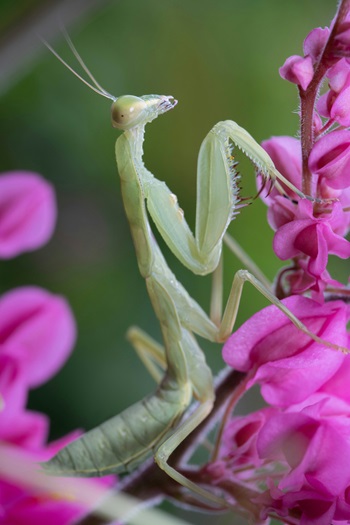
Have you ever heard of a praying mantid? That’s mantid with a “D”, not a praying mantis. The distinction is simple. All mantises are mantids, but not all mantids are mantises. Think of it like squares and rectangles, but if that’s too much of a hassle, don’t worry about it. Mantis is still perfectly acceptable in casual conversation. Regardless of what you call this insect, there’s no denying that mantids are highly effective at hunting other insects. In fact, mantids are so optimized for hunting that they’re able to take down a surprising variety of prey, including hummingbirds!
Although mantids are classified as a beneficial insect due to their ability to effortlessly eliminate swarms of pests and keep insect populations under control without resorting to harsh chemical pesticides, it is important to note that mantids do not discriminate when it comes to their prey. Mantids will happily eat common garden scourges such as aphids, mosquitoes, and caterpillars. They will attack bugs in all stages of their lifecycle, from eggs to larvae to mature adults. But they will also eat beneficial insects, such as lacewings, ladybugs, and butterflies. As mentioned earlier, large, and bold mantids will even stalk hummingbirds, plus small lizards, mice, and more are all game for this efficient predator. Finally, mantids will also cannibalize each other. With all of this in mind, is it worth introducing mantids to your garden as a form of pest control?
Mantids are a great source of natural pest control as long as they are not your only source of pest control. Introducing a small number of mantids to your garden will allow you to keep your insect population low. However, they should also be combined with other natural pesticides, such as the biopesticides offered by ARBICO Organics. Additionally, limit the number of mantids that you introduce at once to your garden. While mantids will cannibalize each other, they do tend to go for easy prey, such as ladybugs or aphids if they are available. Before they take out each other, the overall insect population will suffer.
One underrated aspect of using praying mantises is how popular they are with children. If you have kids, hatching mantids can be a great way to engage them with gardening. Mantids are shipped in egg sacs that are known as ootheca. Once the mantids hatch, kids are typically interested in how different mantids look from generic insects. If they’ve only seen houseflies, beetles, and ants, mantids are striking because of their size and their unique front legs.
If you’re looking to include mantids in your garden, know that they thrive in areas with tall grasses, bushes, and flowering plants. These plants offer hiding places for mantids to wait for prey and also attract insects for them to hunt. Mantids will leave your garden if prey is not available. Keep in mind that mantids are insects, which means that they are cold blooded and reliant on their environment to regulate their temperature. Adding ornamental rocks or branches around your garden can create a more diverse environment, which mantids appreciate.
Interested in getting mantids for your garden? For over 40 years, ARBICO Organics continues to produce innovative means of natural biological pest control and fertilizer for the hobbyist and professional grower alike. View their mantid egg cases by following this link.


Comment here